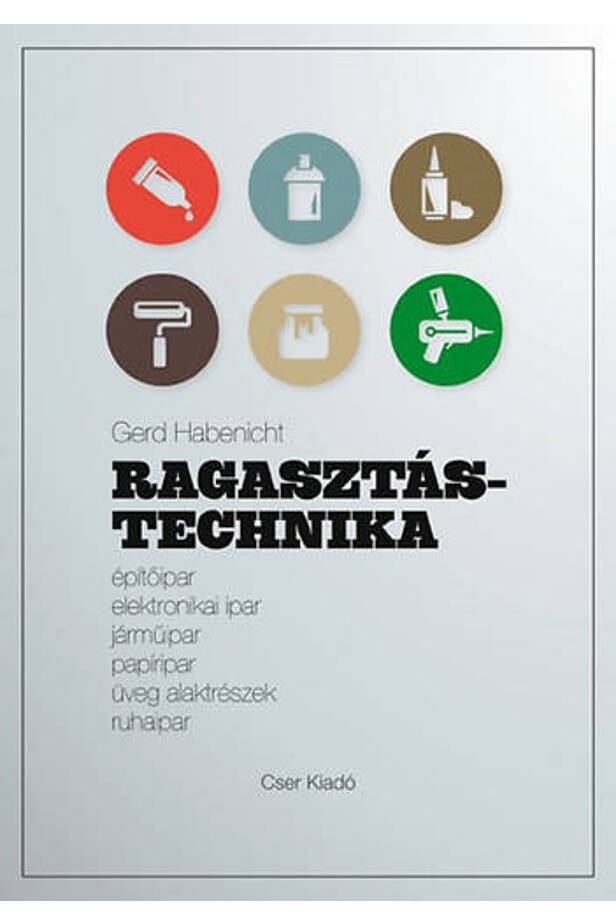Gluing technology
Delivery time: 2 - 3 business days
Quantity:
HUF 4,990
Description
Filling the textbook on industrial bonding techniques. In parts of the industry, the strength of the joint for parts joined together by gluing is the same as the strength of screw, welded or soldered joints. Due to the advantages of gluing operations and state-of-the-art adhesives, the use of glued joints is spreading rapidly. The book describes in detail and thoroughly the theory of gluing, the possibilities of its application and the adhesives. The volume is the Hungarian edition of the book entitled German Industrial Bonding Technology, which has already been published in 6 editions in German. From the contents: 1. Introduction 1.1. Bonding as a bonding process 1.2. Advantages and disadvantages of gluing 1.3. Concepts and definitions 2. Structure and subdivision of adhesives 2.1. Structure of adhesives 2.2. Distribution of adhesives 2.3. Adhesive additives and adhesion promoters 3. From adhesive to adhesive layer 3.1. Reactive curable adhesives - basic concepts 3.2. Two-component (2K-) and one-component (1K-) reaction curable adhesives 3.3. Properties of the adhesive layers 4. Important reaction adhesives 4.1. Epoxy resin adhesives 4.2. Polyurethane (PUR) adhesives 4.3. Acrylate adhesives 4.4. Unsaturated polyester resins (UP resins) 4.5. Phenolic resin adhesives 4.6. Silicones and MS polymers 4.7. Summary of reaction curable adhesives 4.8. Adhesive films 4.9. Sealants 4.10. Polymer mortars 5. Physically binding adhesives 5.1. Hot melt adhesives 5.2. Solvent adhesives 5.3. Contact adhesives 5.4. Dispersion adhesives 5.5. Plastisols 5.6. Pressure adhesives, adhesive tapes 5.7. Adhesive strips 5.8. Glue sticks 5.9. Adhesives based on natural raw materials 5.10. Inorganic based adhesives 6. Binding forces in adhesives 6.1. Bonding forces between the adhesive layer and the piece to be joined (adhesion) 6.2. Wetting 6.3. Surface tension 6.4. Bonding forces within the adhesive layer (cohesion) 7. Preparation of adhesives 7.1. Surface treatment 7.2. Use of adhesives 7.3. Repair adhesives 7.4. Defects that may occur during gluing and their correction 7.5. Safety measures to be applied during gluing 7.6. Quality Assurance - Quality Management 7.7. Bonding technology training 8. Selection of adhesive 8.1. General remarks 8.2. Factors influencing the choice of adhesive 8.3. Selection criteria 9. Bonding properties of major structural materials 9.1. Metals 9.2. Plastics 9.3. Glass 9.4. Bonding of rubber / rubber 9.5. Gluing wood / wood 9.6. Bonding of porous materials 10. Strength, sizing and testing of adhesives 10.1. The concept of strength 10.2. Test procedures 10.3. Flexible gluing 10.4. Shaft / hub joints 11. Industrial applications of gluing 11.1. Bonding in the aerospace industry 11.2. Bonding in the automotive industry 11.3. Bonding in the electronics industry 11.4. Bonding of optical components 11.5. Gluing and insulation in construction 11.6. Bonding in the paper processing industry 12. Structural design of adhesives 13. Appendix 13.1. Conversion factors between Anglo-Saxon units and SI units in gluing calculations 13.2. German and English (English and German) Terms 14. Bibliography 15. Explanation of Terms
| publisher | Cser For Rent |
|---|---|
| writer | Gerd Habenicht |
| scope | 192 |
| volume unit | oldal |
| ISBN | 9789632783420 |
| year of publication | 2013 |
| binding | carton |

Sign up for our newsletter and be the first to know!
A Zamnia hírlevélre való feliratkozással megerősítem, hogy betöltöttem a 16. életévemet.


